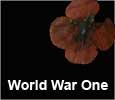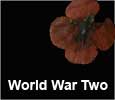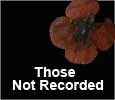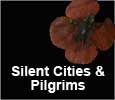

A B C D E F G H I J K L M N O P Q R S T U V W X Y Z
World War Two Roll of Honour
Flying Officer Robert Douglas MacDonald
November 24, 1942
99 Squadron, Royal Canadian Air Force
Service Number J/10405
Chittagong War Cemetery, Pakistan. Age 20
Son of Robert Maitland and Clara May MacDonald, Chilliwack, B.C.Douglas MacDonald was born in Revelstoke, British Columbia. He attended Atchelitz Elementary and the Junior‑Senior High School in Chilliwack where he developed interests in photography and chemistry. Away from school he liked to fish and hunt. In 1940, at the age of 18, he enlisted in the R.C.A F. and was the head of his class at Summerside, P.E.I. receiving the silver Skyway Trophy. MacDonald, who was trained as an air observer, served with 99 Squadron, a unit that was equipped with Wellington bombers. On November 24, 1942, enemy fighters attacked MacDonald's aircraft after a raid over Burma. The Wellington's undercarriage was damaged and one crewman was injured. Rather than bail out, the crew remained with the aircraft and made a crash landing at an airfield in India. The Wellington immediately caught on fire and Flying Officer MacDonald was the last out of the aircraft. He died in hospital twelve hours later from severe burns sustained in the crash.
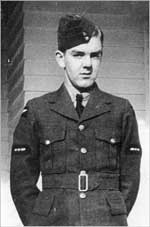
Flight Lieutenant Ronald Ernest MacFarlane, D.F.M.
December 16, 1943
101 Squadron, Royal Canadian Air Force
Service Number J/16696
Lemsterland (Lemmer) General Cemetery, Friesland, Netherlands. Age 21
Son of John and Phoebe MacFarlane, Chilliwack, B.C."Ronnie" MacFarlane was born in Chilliwack and attended Chilliwack High School. He was prominent in athletics and was an active member of Cooke's Presbyterian Church. He worked for Pickards until he joined the R.C.A.F. in February 1941. Ronnie trained as a pilot, and received his wings in September. In October he went overseas and during the year captained a Wellington bomber. A veteran of several operations against targets in Italy and Germany, MacFarlane was awarded the Distinguished Flying Medal for gallant and distinguished services receiving the award at a Buckingham Palace investiture. When over the Ruhr MacFarlane's Lancaster bomber was hit and one crewman was killed and another injured. MacFarlane avoided three German night fighters by diving to 80 feet above the sea. Continuing evasive manoeuvres, the Lancaster was shot up by the three night fighters and pursued by five others. Despite the enemy's efforts, MacFarlane landed safely at base. On the night of his crew’s loss, MacFarlane was piloting a Lancaster that was shot down by German night fighter Oblt Heinz-Wolfgang Schnaufer, the highest scoring German night fighter pilot of the Second World War and MacFarlane became his 38th victim. Schnaufer destroyed 121 allied aircraft during the war and on the night of December 16, 1943 he destroyed four Lancasters. MacFarlane’s aircraft exploded over the Banco polder and three members of the crew are recorded on the Runnymede Memorial and five buried at Lemsterland. The crew members were Flying Officer L.E. Thompson R.C.A.F., Sergeants J.E. Clarke, L.D. Wilson, F.R. Westall, D.B. Harvey, J. Ireland and E.B.E. Jordan of the R.A.F. Schnaufer survived the war.
Citation for award of the Distinguished Flying Medal.
“One night in January 1943, Flight Sergeant MacFarlane was captain of an aircraft which was attacked by three Junkers 88. When returning from an operational sortie the mid-upper gunner was killed, the rear gunner severely wounded and the aircraft was badly damaged. Flight Sergeant MacFarlane took violent evasive action and succeeded in shaking off the enemy aircraft. Shortly afterwards the bomber was held by searchlights and engaged by intense anti-aircraft fire, and height was lost down to 4,000 feet in avoiding further damage. Soon afterwards a formation of five hostile fighters was sighted but when they attempted to attack Flight Sergeant MacFarlane skilfully avoided them. By masterly airmanship this airman extricated his aircraft from a perilous situation and flew it safely back to this country.”
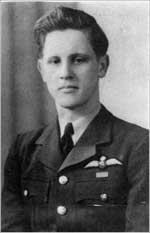
Pilot Officer Alexander Harvey MacLeod
15 October 1944
1664 Conversion Unit, Royal Canadian Air Force
Service Number J/92113
Runnymede Memorial, Surrey, England. Age 22
Son of William Ray and Beulah Rossland MacLeod, Cultus Lake, B.C.Alexander MacLeod attended Chilliwack High School and Senior Matriculation in 1941. He worked on his uncle's farm in Atchelitz until he enlisted in the R.C.A.F. in August 1942. He graduated as a Sergeant Pilot in Vulcan, Alberta in October 1943 and was sent overseas. He was commissioned a year later and on October 15, 1944, was posted missing when his Halifax aircraft, of 1664 Conversion Unit, was lost. This aircraft failed to return from a bullseye training operation and a cross‑country navigation exercise over the North Sea. The mission acted as a diversion and was sent towards Heligoland as one of 141 crews. MacLeod’s aircraft was lost without trace and the crew killed were R.C.A.F. members Sergeants W.R. Wickham, B.J. Becker, G.A.F. Whinfield, H.W. McKay, B.T. Taylor and Sergeant L.A. Howser of the R.A.F. MacLeod’s uncle was Air Commodore Earl MacLeod of the R.C.A.F. His uncle Malcolm MacLeod was killed during the First World War and is also commemorated on the Chilliwack War Memorial.
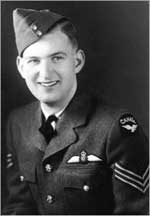
Corporal Lester Harvey McConnell
26 December 1943
Seaforth Highlanders of Canada
Service Number K/52198. Original member of the Seaforth Highlanders of Canada
Moro River Canadian War Cemetery, Ortona, Italy. Age 28
Son of Joseph Andrew and Gertrude Cecil McConnell, Chilliwack, B.C.Corporal Les "Toby" McConnell was born in the Cheam district and grew up on the farm that his grandfather had homesteaded in 1873. He attended Chilliwack High School and was a basketball player and contributed many articles for the High School newspaper. Lester was a member of Cooke's Presbyterian Church and was a Trail Ranger leader at Cheam United Church. Upon the declaration of war, McConnell enlisted with the Seaforth Highlanders and went overseas with their first draft in December 1939. He participated in the invasion of Sicily and was wounded. Sent to a hospital in North Africa for treatment, he returned to his unit upon recovery. On December 26, 1943, McConnell was killed in the severe fighting around Ortona. George Good, another Seaforth, also of Chilliwack was killed the same day.
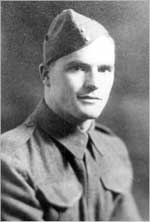
Private Angus Martin McKenzie
September 3, 1944
Westminster Regiment
Service Number K/47659. An original member of the Westminster Regiment (M.G.)
Gradara War Cemetery, Italy. Age 28
Son of Norman and Marion McKenzie, Vancouver, B.C.On September 3, 1944, Private A.M. McKenzie was killed in action on the approach to Coriano Ridge, Italy. The ridge was part or the German "Gothic Line" and while approaching the main objective, McKenzie, a member of a Vickers machine gun crew, was lost when the area was heavily shelled.
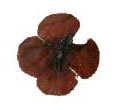
Flight Sergeant Nathaniel Wesley McNair
November 26, 1943
460 Squadron, Royal Canadian Air Force
Service Number R/166512
Sage War Cemetery, Oldenberg, Germany. Age 26
Son of Nathaniel James David and Jennie McNair, Chilliwack, B.C.Born in Rosedale, Nathaniel McNair was educated at Rosedale Public and Chilliwack High Schools. He had his own paper route that he started when he was twelve. The route covered over 25 miles and Wesley delivered the news through winter and summer most cheerfully. Following school he worked as a logger near Harrison Lake and occupied his spare time hunting and fishing. Wes enlisted in the R.C.A F. in January 1942 and in February 1943 graduated from the Air Observer School in Regina as an air bomber. Overseas he served with 460 Squadron, a bomber unit of the Royal Australian Air Force. McNair was lost on a raid against Berlin when his Lancaster bomber crashed November 26, 1943 at Grossenkneten. All members of the crew were first buried in Neuer Friedhof. The crew comprised Sergeants E.J. Stones R.A.A.F., H.G. Jones, K.G. Smith, W. Belton, J.H. McIvor all of the R.A.F. and Sergeant G.D. Arnott R.C.A.F.
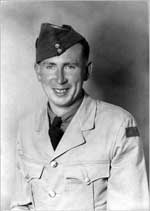
Private Wesley Ronald Mercer
February 28, 1945
Seaforth Highlanders of Canada
Service Number K/42559. Original Unit of Service – Rocky Mountain Rangers
Coriano Ridge War Cemetery, Italy. Age 22
Son of Stinson and Blanche Mercer, Rosedale, B.C.Born in Rosedale, Wesley joined the Rocky Mountain Rangers on July 2, 1940. With the "Rangers" he played the drums in the regimental band. In January 1943 Wesley went overseas with the Seaforth Highlanders of Canada and took part in the invasion of Sicily. He was killed in action in Italy, when the Seaforths were preparing to leave Italy for the Netherlands, February 28, 1945.
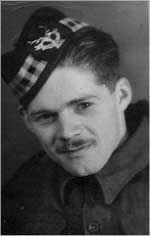
Warrant Officer II Donald Montgomery
April 3, 1943
415 Squadron, Royal Canadian Air Force
Service Number R/101199
Littlehampton Cemetery, Sussex, England. Age 20
Son of Mr. and Mrs. William Montgomery, Cultus Lake, B.C.Born to a farming family living in Delta, British Columbia, Donald Montgomery received his education in Delta schools and was active in junior farming. He was a prominent member of the Delta Boys' and Girls' Potato Club and the Delta Grain Club, and won many agricultural prizes. On his eighteenth birthday, December 28, 1940, Donald enlisted in the R.C.A.F. and commenced training at Penhold, Alberta and later at 18 Elementary Flying Training School. On April 3, 1943, as a pilot with 415 Squadron, he flew a Hampden in an exercise with two Typhoon fighter‑bomber aircraft. While engaged in evasive action, the Hampden went out of control and into a spin at 2000 feet. Failing to recover, the aircraft crashed near Marsh Farm in Sussex, England. No one, of the four-man crew, survived.
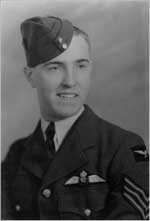
Leading Air Craftsman William Strongren Murray
March 20, 1941
9 Service Flying Training School, Royal Canadian Air Force.
Service Number R/58529
Peoples Cemetery Summerside, Prince Edward Island. Age 24
Son of Frederick A. and Hulda Johanna C. Murray. Chilliwack, B.C.Born in New Westminster in 1917, William Murray was educated in Vancouver and Kamloops. Prior to the Second World War he was a provisional Pilot Officer with the R.C.A.F. at Trenton, Ontario, but took his discharge in May 1938 and moved to Vernon. In Vernon he worked for the Hudson's Bay Company until he rejoined the R.C.A.F. in August 1940, under the British Commonwealth Empire Training Plan. His father, Mr. F.A. Murray, was the Manager of the Bank of Montreal in Chilliwack and William's mother passed away in Chilliwack, January 14, 1941. On March 20, 1941 William was piloting a Harvard aircraft at 9 Service Flying Training School at Summerside, P.E.I., when he encountered a snow storm during a cross‑country exercise, and crashed into a hill eight miles north of Sussex, New Brunswick.
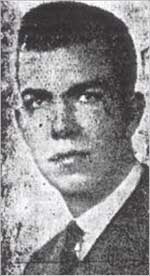
Chilliwack Museum and Archives 45820 Spadina Avenue, Chilliwack, BC, Canada V20 1T3 [604.795.5210]
